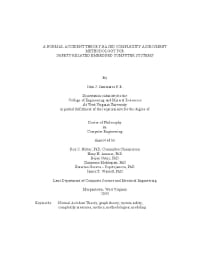Mining Publication: A Normal Accident Theory-Based Complexity Assessment Methodology for Safety-Related Embedded Computer Systems
Original creation date: December 2003
Authors: JJ Sammarco
NIOSHTIC2 Number: 20024286
[Ph.D. Dissertation] Morgantown, WV: West Virginia University, Department of Computer Science and Electrical Engineering, 2003 Dec; :1-233
Computer-related accidents have caused injuries and fatalities in numerous applications. Normal accident theory (NAT) explains that these accidents are inevitable because of system complexity. Complex systems, such as computer-based systems, are highly interconnected, highly interactive, and tightly coupled. We do not have a scientific methodology to identify and quantify these complexities; specifically, NAT has not been operationalized for computer-based systems. Our research addressed this by operationalizing NAT for the system requirements of safety-related computer systems. It was theorized that there are two types of system complexity: external and internal. External complexity was characterized by three variables: system predictability, observability, and usability - the dependent variables. Internal complexity was characterized by modeling system requirements with software cost reduction dependency graphs, then quantifying model attributes using 15 graph-theoretical metrics - the independent variables. Dependent variable data were obtained by having 32 subjects run simulations of our research test vehicle: the light control system (LCS). The LCS simulation tests used a crossover design. Subject perceptions of these simulations were obtained by using a questionnaire. Canonical correlation analysis and structure correlations were used to test hypotheses 1 to 3: the dependent variables predictability, observability, and usability do not correlate with the NAT complexity metrics. Five of fifteen metrics proposed for NAT complexity correlated with the dependent data. These five metrics had structure correlations exceeding 0.25, standard errors <0.10, and a 95% confidence interval. Therefore, the null hypotheses were rejected. A Wilcoxon signed ranks test was used to test hypotheses 4 to 6: increasing NAT complexity increases system predictability, observability, and usability. The results showed that the dependent variables decreased as complexity increased. Therefore, null hypotheses 4 to 6 were rejected. This work is a step forward to operationalize NAT for safety-related computer systems; however, limitations exist. Opportunities addressing these limitations and advancing NAT were identified. Lastly, the major contribution of this work is fundamental to scientific research: to gain knowledge through the discovery of relationship between the variables of interest. Specifically, NAT has been advanced by defining and quantifying complexity measures and showing their inverse relationship to system predictability, observability, and usability.

NIOSHTIC2 Number: 20024286
[Ph.D. Dissertation] Morgantown, WV: West Virginia University, Department of Computer Science and Electrical Engineering, 2003 Dec; :1-233